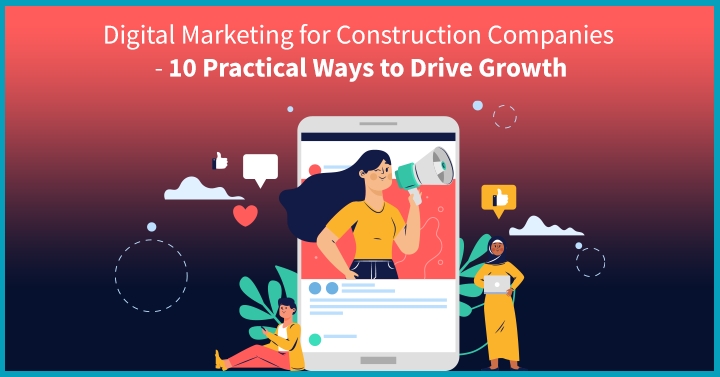Have you ever wondered what sets the most successful B2B blogs apart from the vast ocean of other content?
According to HubSpot, the answer lies in a simple yet impactful element: “internal linking,” one of the top-ranking factors in Google’s algorithm.
That’s right – mastering the art of internal linking can give your B2B blog the boost it needs to shine in search engine results and captivate your target audience.
Imagine your website as a vast library, each blog post serving as a carefully crafted book on your industry expertise. Now, picture internal links as the secret passageways or GPS that guide readers and search engines through this knowledge repository.
This interconnected web of internal links acts as a powerful tool for elevating your content’s visibility, enhancing user experience, and, ultimately, bolstering your SEO results.
In this blog, we’ll walk you through the 10 Best Practices for Internal Linking in B2B Blogs, ensuring your content not only speaks to search engines but resonates with your audience.
2. What is Internal Linking?
Internal linking refers to linking to other relevant pages within your website. It’s like creating a map of your website, where hyperlinks connect each page to other pages. These links are used to navigate your website and help search engines understand the structure and hierarchy of your content. It is an essential part of targeted SEO, as it can help to distribute link equity throughout your site and improve the visibility and rankings of your web pages.
In the context of B2B blogs, internal linking plays a crucial role in guiding visitors to relevant content, establishing a hierarchy of information, and distributing page authority throughout the site. It also enables you to showcase the depth and breadth of your expertise, enhancing your credibility in the eyes of both readers and search engines. When executed effectively, internal linking can enhance user experience, increase the time visitors spend on your site, and ultimately boost your search engine rankings.
The main idea of internal linking is about connecting related posts and strategically directing your audience to valuable resources, product pages, and lead-generation forms. By strategically interconnecting these pieces of content, you can effectively nurture leads, establish your site’s authority, and improve its overall search engine visibility.
For example, let’s say you have a B2B blog, and you’ve written an article about the benefits of content marketing. Within that article, you might include a hyperlink to another relevant post on your site, such as “5 tips for creating a successful content marketing strategy.” This helps your readers discover more valuable content on your site and signals to search engines that these pages are related and should be crawled together.
3. Benefits of Internal Linking Practices in B2B Blogs
Internal linking plays a crucial role in shaping the SEO landscape for B2B blogs. Here are a few reasons why it holds such pivotal importance:
- Improved SEO
One of the main reasons to prioritise internal linking practices in B2B blogs is to improve search engine optimisation (SEO). By linking to other relevant pages within your site, you can signal to search engines that your content is valuable and informative. This can boost your site’s visibility in search engine results pages (SERPs) and drive more organic traffic to your blog.
- Increased User Engagement
Effective internal linking best practices can keep your readers engaged and on your site longer. By providing easy navigation to other relevant pages and articles, you can encourage readers to explore more of your content and potentially convert it into leads or customers. This can lead to higher engagement rates and more business success.
- Better Content Structure
Internal linking can create a more organised and structured content experience for your readers. By linking related pages and articles together, you can create a logical flow of information that is easy for readers to follow and understand. This can help establish your authority and thought leadership in your industry and improve your readers’ perception of your brand overall.
4. What Are the 3 Types of Internal Links?
- Navigational Links
Navigational links appear in a website’s main menu, sub-menu, or sidebar. These links help visitors navigate to different sections or pages of the website quickly and easily. They typically include the homepage, about us, services, products, and contact us pages. Also, they should be placed in prominent locations on the website to be easily accessible and visible to visitors.
- Contextual Links
Contextual links are links that are embedded within the content of a webpage. These links are typically used to provide additional information to the reader or to help visitors navigate to related content on the website. Contextual links can be used to link to related blog posts, articles, or product pages. When used correctly, they can improve the user experience and increase engagement on the website.
- Footer Links
Footer links are links located in a website’s footer section. These links are typically used to provide visitors with quick access to important pages such as the privacy policy, terms and conditions, sitemap, and contact us page. These are often included on every page of the website, and they can help improve its navigation and usability.
5. 10 Best Practices for Internal Linking in B2B Blogs
Optimising your internal links strategically is key to improving the effectiveness of your SEO. Here’s a comprehensive list of the top 10 best practices to guide the strategic implementation of your internal links:
5.1 Use Relevant Anchor Text
Anchor text is the clickable text that appears in a hyperlink and should accurately describe the content of the linked page. By using relevant anchor text, you can help readers and search engines understand the context of the linked page.
For example, if you’re writing a blog post about the benefits of cloud computing, and you want to link to a page on your site that provides more in-depth information about cloud security. In that case, you might use the anchor text “cloud security” instead of a generic term like “click here.” This not only helps readers understand what they’ll find when they click the link, but it also helps search engines understand the link page’s relevance.
You can prevent the links from appearing spammy or manipulative to search engines by using relevant anchor text. Typically, using irrelevant or misleading anchor text is seen as an attempt to manipulate search rankings, which could harm your SEO efforts in the long run.
So, when adding internal links to your B2B blog, make sure to use relevant and descriptive anchor text that accurately reflects the content of the linked page.
5.2 Use the Right Amount of Internal Links
When adding internal links to your site, it is vital to strike the right balance between too few and too many internal links. Using too few internal links can make it difficult for readers to navigate your site and find related content. Conversely, using too many can make your content look spammy and could lead to Google penalties.
So, what’s the right number of internal links to use in your B2B blog? While there’s no one-size-fits-all answer, a good rule of thumb is to use internal links only when they are relevant and valuable for your readers. Each link should provide additional value to your content and help navigate the readers to related topics or information.
For example, if you’re writing a blog post about the benefits of content marketing, and you want to link to a previous post on your site that provides tips for creating engaging content, it would be appropriate to include that internal link. But adding multiple internal links to irrelevant pages or over-linking within a single post can be seen as spammy.
Ultimately, using the right number of internal links comes down to providing value to your readers and improving their experience on your site. So, when adding internal links to your B2B blog, focus on quality over quantity and only include valuable links for your readers.
5.3 Link to Relevant Pages
When you link to other pages on your website, you’re allowing your readers to explore your website further, find more information about a specific topic, or navigate to another part of your site. However, not all links are created equal. You must link to relevant pages to get the most out of your internal linking strategy. What does this mean? You should link to pages on your website related to the content you’re discussing.
For example, you’re writing a blog post about the benefits of using cloud-based software for B2B companies. You should link to other pages on your website that provide more information on this topic, such as a page that explains the different types of cloud-based software available or outlines the features of your company’s cloud-based software solution.
So, when it comes to internal linking best practices in B2B blogs, always link to relevant pages. This will help improve the user experience for your readers and boost your website’s SEO at the same time.
5.4 Use Keywords in Anchor Text and Page Content
Descriptive anchor text helps readers and search engines understand what the linked page is about. One way to do this is by using keywords in your anchor text. In addition to using keywords in your anchor text, using them in your page content is essential. This helps search engines understand your page and can improve your rankings for relevant keywords.
For example, you’re writing a blog post about the benefits of using a particular B2B software solution. You might use software-related keywords throughout the post, such as the product name or features. When you link to pages on your website that provide more information about the software, you can use these keywords in your anchor text and on the linked page. By using keywords in your anchor text and page content, you’re helping to create a more cohesive internal linking strategy that signals to search engines what your website is all about.
Using keywords in anchor text and page content is one of the best practices for internal linking in B2B blogs. Just remember to use keywords naturally and not stuff them in unnaturally – search engines can spot this and may penalise your website for over-optimisation.
5.5 Use Breadcrumbs
Breadcrumbs are internal links that help users navigate your website and understand where they are within your site’s hierarchy. They’re called breadcrumbs because they typically resemble a trail of breadcrumbs that leads back to the homepage. Breadcrumbs are especially useful for B2B websites with many pages and a complex navigation structure.
For example, let’s say you run a B2B software company that offers several different products. You might have a product page for each product, features, pricing, and support. By using breadcrumbs on each page, you can help users understand how each page fits within your website’s hierarchy and easily navigate back to the homepage or other relevant pages.
Here’s an example of what breadcrumbs might look like on a B2B software product page:
Home > Products > Cloud-Based Software > Product Name
In this example, the user can easily see that they’re on a product page for a specific cloud-based software product, and they can navigate back to the main products page or the homepage with just a few clicks. Using them provides a clear and easy-to-use navigation structure that can improve the user experience and ultimately help your website succeed.
5.6 Use Descriptive and Clear Link Text
Link text is often used to describe the linked page’s content. By making it descriptive, your users understand what they can expect to find when they click on the link. Also, it helps search engines understand the relevance of the linked content.
For example, let’s say you’re writing a blog post about B2B marketing strategies, and you want to link to a page on your website that provides more information about social media marketing. Instead of using generic link text like “click here,” you might use something like “learn more about social media marketing for B2B businesses.” This descriptive link text tells users precisely what they can expect to find when they click on the link, and it also helps search engines understand the relevance of the linked content.
When you use clear and descriptive link text, you’re also helping to improve the overall user experience on your website. By using clear and descriptive link text, you’re helping to create a more user-friendly and informative website that can improve the overall success of your B2B business.
5.7 Link to High-Quality Authoritative Pages
Google considers some of the webpages as highly authoritative based on the quality of information they contain. It is vital to link to authoritative pages – when creating internal links in your B2B blog. This helps establish your website as a credible source of information and can also improve your search engine rankings. By linking to authoritative sources, you’re providing your readers with valuable information and helping to establish your website as a credible source of information. This can improve your website’s reputation and increase your audience.
Here’s an example of what linking to a high-quality, authoritative page might look like in a B2B blog post: “According to a recent study by [authoritative source], businesses that use social media for B2B marketing see an average increase in sales of 20%. Check out the full study for more insights.” In this internal links example, the author links to an authoritative source to support their argument and provide valuable information to their readers.
Linking to high-quality and authoritative pages is one of the best practices for internal linking in B2B blogs. So, be sure to take the time to carefully choose your external links and link to sources that provide high-quality content.
5.8 Use Logical Linking Structure
A logical linking structure is the organisation of hyperlinks within a website in a way that makes sense and provides a clear path for users to navigate through the content. It’s essential to use a logical linking structure that helps users easily navigate your content and find related information. This can improve the user experience on your website and keep users engaged with your content for longer.
For example, you’re writing a blog post about B2B sales strategies and want to link to another page on your website that provides more information about lead generation. Instead of simply inserting a link to the other page without any context, you might first introduce the topic of lead generation in your blog post and then link to the other page as a related resource.
A logical linking structure is amongst the important best practices for internal linking in B2B blogs. By following this practice, you’re creating a logical linking structure that helps users understand how your website’s different pieces of content relate to each other. This can improve the overall user experience and keep users engaged with your content for longer.
5.9 Regularly Check for Broken Links
Broken links are hyperlinks on a webpage that no longer lead to their intended destination. This can happen for various reasons, such as the target webpage being deleted, the URL being changed or mistyped, or the server hosting the target webpage is down. They can negatively impact the user experience on your website and hurt your search engine rankings.
For example, if you’re linking to an internal resource in your blog post and that resource has been moved or deleted, the link will no longer work, and users will receive an error message. This can be frustrating for users and make your website appear unprofessional.
Regularly checking for broken links on your website and fixing them as soon as possible can help improve the user experience and ensure that your website functions correctly. Many free online tools can help you quickly and easily check for broken links on your website.
5.10 Monitor and Update Internal Links Regularly
Internal linking is not a one-time task; it requires ongoing monitoring and updates to ensure the links are still relevant and helpful to your readers. By monitoring and updating your internal links regularly, you can improve the user experience on your website and keep your content fresh and up-to-date.
For example, let’s say you wrote a blog post about the top digital marketing trends for 2023 and included internal links to other relevant blog posts on your website. As time goes on and new trends emerge, some of those links may no longer be relevant or useful to your readers. By monitoring and updating those links regularly, you can ensure that your content remains valuable and engaging to your readers.
6. Tools for Analysing Internal Linking Structure
When it comes to internal linking, leveraging specialised tools for analysing and visualising your website’s internal linking structure can provide actionable insights and facilitate informed decision-making. Here are several tools that can aid in analysing internal linking structure in B2B blog content:
- Google Search Console: A fundamental tool for website analysis, Google Search Console offers a range of features for understanding how internal links are indexed and perceived by Google. The “Links” report provides valuable data on internal links, including the pages with the most internal links and the anchor text used.
- Screaming Frog SEO Spider: This comprehensive website crawling tool can be utilised to analyse internal links across your B2B blog content. By examining factors such as link depth, anchor text distribution, and link authority flow, you can gain insights into the effectiveness and structure of your internal linking strategy.
- Ahrefs: Known for its robust backlink analysis capabilities, Ahrefs also offers features for internal link analysis. The “Site Explorer” tool provides visibility into internal links, including the distribution of internal link equity and the top linked pages within your website.
- SEMrush: As a versatile SEO toolkit, SEMrush includes features for internal link analysis, allowing you to explore the internal linking structure of your B2B blog content and identify opportunities for optimisation. The “Internal Linking” report provides insights into the distribution of internal links and their impact on SEO performance.
- Link Whisper: This WordPress plugin is designed specifically for streamlining the internal linking process, offering automated suggestions for relevant internal links within your blog content. By leveraging its features, you can efficiently optimise internal linking across your B2B blog posts and pages.
7. Internal Linking Mistakes to Avoid in B2B Blogging
While internal linking can yield significant benefits, certain mistakes can hinder its effectiveness. To ensure the optimal performance of your internal linking strategy, it is crucial to avoid the following pitfalls:
- Over-Optimisation: Excessive use of exact match anchor text or repetitive linking patterns can be flagged as manipulative by search engines. This can lead to potential penalties and decreased visibility.
- Irrelevant Linking: Linking to unrelated or irrelevant pages within your blog can confuse users and dilute the contextual relevance of your content, impacting both user experience and SEO performance.
- Orphaned Content: Neglecting to link important pages within your blog can result in low-traffic. These isolated pages will miss out on the benefits of internal linking and fail to contribute to the overall SEO strategy.
8. How can a Digital Marketing Agency Help?
Digital marketing agencies possess the expertise and resources to conduct comprehensive website audits, identify opportunities for strategic internal linking, and rectify any existing issues. By leveraging their knowledge of SEO best practices, digital marketing agencies implement internal linking strategies that align with the overall marketing objectives of your business.
Growth Ganik is a full-stack digital marketing agency with over 15 years of experience curating effective content marketing and SEO strategies for organisations of various sizes. Our agency specialises in extracting insights from user behaviour and engagement. This helps us make informed decisions when structuring internal links. Our proficiency in content optimisation and SEO helps us develop internal linking strategies for B2B blogs that help drive organic traffic and enhance the website’s visibility within the competitive B2B landscape.
9. FAQS
- How to Do Internal Linking in Blogs?
Internal linking in blogs can be done by linking to relevant pages within your website, using descriptive and clear link text, and creating a logical linking structure.
- Which Is the Best Way for Internal Linking?
The best way to do internal linking depends on your website’s and your audience’s specific needs. However, using relevant and descriptive link text and creating a logical link structure are best practices.
- How Many Internal Links Should Appear in a Blog Post?
There is no fixed number of internal links that should appear in a blog post. Instead, it depends on the post’s length and content and the links’ relevance.
- How Many Internal Links per Page SEO?
There is no fixed number of internal links per page recommended for SEO. Instead, it depends on the content and structure of the page.
- How to Add Internal Links Within Blogger Posts?
To add internal links within Blogger posts, highlight the text you want to link and click on the “Link” icon in the toolbar. Then, choose the page you want to link to.
- How to Find Internal Links to a Page?
To find internal links to a page, you can use a website crawler tool or Google Search Console to view a list of all internal links that point to that page.
- How to Add Internal Links in WordPress?
To add internal links in WordPress, highlight the text you want to link and click on the “Link” icon in the toolbar. Then, choose the page you want to link to. You can also use plugins like Yoast SEO to improve your internal linking strategy.

















